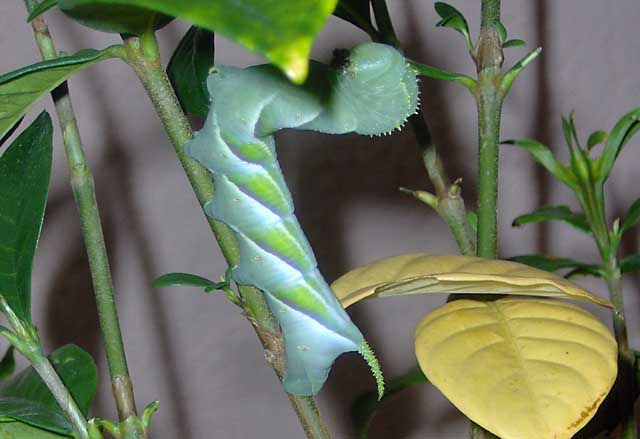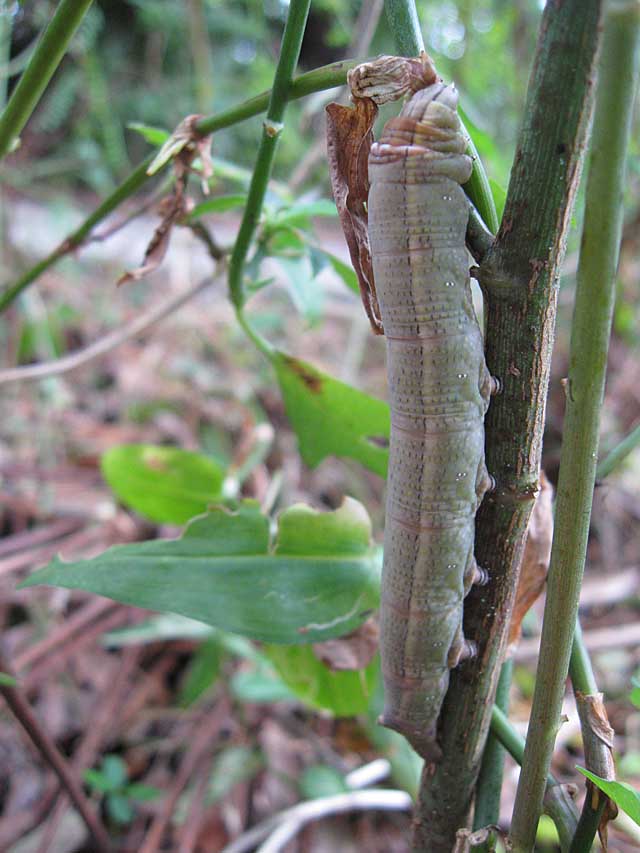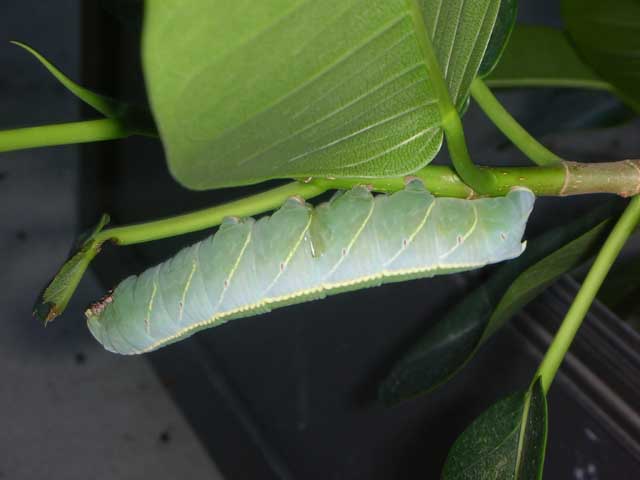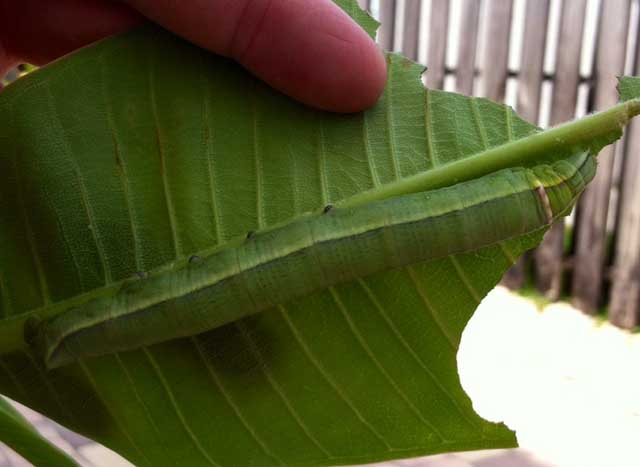Sphinginae subfamily
Sphingini tribe:
 |
Agrius cingulata,
WO Pink-spotted hawkmoth:
Plants in Convolvulaceae family,
Ipomoea batatas (sweet potato); in Solanaceae family,
(Datura) (jimsonweed) and related plants. Also a brown form. Look for very large, dark
spiracular circles.
|
 |
Ceratomia catalpae
WO,
Catalpa Sphinx:
Young caterpillars feed gregariously on Catalpa species
(Catalpa bignoniodes, C. speciosa) in
Bignoniaceae family, skeletonizing foliage.
Larvae are mostly white in early instars.
generally more eastern species |
 |
Ceratomia undulosa
WO, Waved
Sphinx:
Fraxinus, Ligustrum, Quercus, Crataegus and
Chionanthus virginicus are listed as hosts.
In the fifth instar, the spiracular ovals are decidedly red and the
anal horn is off-white to pinkish laterally.
|
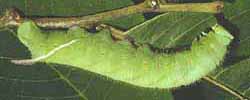
|
Cocytius antaeus,
USGS Giant Sphinx:
Very large. In last instars,
uniform green with adark purple center back line and
very sharp white posterior side slash with some dark green on both
sides of it.
|
 |
Dolba hyloeus
USGS, the Pawpaw Sphinx
Larvae feed on pawpaw (Asimina triloba), littleleaf sweetfern
(Myrica aspleniifolia), possum haw (Ilex decidua), and
inkberry (Ilex glabra) as well as Tall Gallberry Holly
(Ilex coriacea).
Louis Handfield reports larvae probably feed on Ilex verticellata
in Quebec.
|

|
Isoparce cupressi
USGS, Cypress or Baldcypress Sphinx.
Larvae feed on needles of baldcypress (Taxodium distichum) at night and
pupate in shallow underground burrows where second generation
overwinters.
|
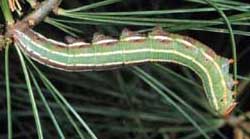 |
Lapara coniferarum
USGS, Southern Pine Sphinx:
Various pine species, including loblolly pine
(Pinus taeda) and longleaf pine (P. pinaster). They are well
camouflaged and are without an anal horn.
|
 |
Manduca quinquemaculatus
WO,
Five-spotted Hawkmoth:
The caterpillars are called Tomato Hornworms and each has a black horn at the end of the abdomen.
Larvae feed on potato, tobacco, tomato, and other plants in the
nightshade family (Solanaceae).
|
 |
Manduca rustica
USGS/DRW, Rustic Sphinx:
Numerous white nodules on top of thorax;
seven pairs of oblique, blue-gray stripes along side of body.
Horn white at base, blue-gray at tip. Many hosts are utilized.
|
 |
Tobacco Hornworms, equipped with a red-tipped horn at the end of the
abdomen, are true gluttons and feed on tobacco and tomato, and
occasionally potato and pepper crops and other plants in the
nightshade family (Solanaceae).
|
Smerinthini Tribe:
 |
Larvae accept willows, birches, and cherries.
I have also found them in the wild on oak in eastern Canada.
The skin is very granulose.
|
 |
The larvae depicted is probably third instar.
There may be more red spotting on the sides
as larvae mature.
|
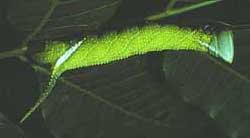 |
Protambulyx strigilis
USGS,
Streaked Sphinx:
Larvae found on Schinus terebinthefolia.
Later instars hide at base of leaf or near base of
tree's trunk when not feeding (all larvae were found on saplings).
Early instar larvae have extremely pointed head capsules, and sometimes have difficulty shedding.
|
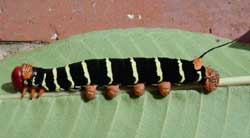 |
The brightly coloured caterpillar is easy to find in gardens. The
larva are big and colourful and easily identified.
|
Macroglossinae subfamily
Dilophonotini tribe:
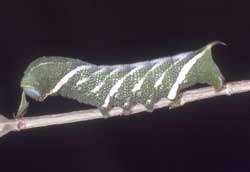 |
Larvae feed on seven year apple, Casasia clusiifolia, and probably
other plants in the madder family. They have been reported on
Indigo-berry (Randia aculeata). |
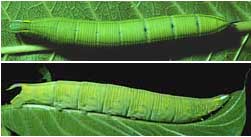 |
Callionima falcifera
WO.
The narrow, flattened head of the larva is clearly visible in the lateral view, left below.
It might be in Broward County as a stray. |
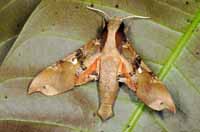 |
may or
may not be present in Broward County. Sorry, no larval image
available at this time.
|
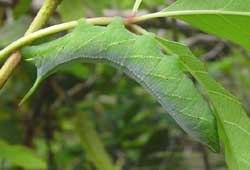
|
The body and wings are dark brown. The forewing has a large black
patch covering most of the outer half of the wing. There is a pale
tan cell spot (dark inner pupil), and a fairly straight median line
to the inside of the cell spot.
|
 |
Erinnyis alope
WO, the Alope Sphinx.
Larvae have several forms and feed on papaya (Carica papaya),
nettlespurge (Jatropha), and allamanda (Allamanda).
|
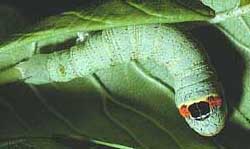 |
Larvae feed on various plants in the dogbane family
(Apocynaceae): Rauvolfia ligustrina, Rauvolfia tetraphylla,
Stemmadenia obovata. There is also a brown form.
|
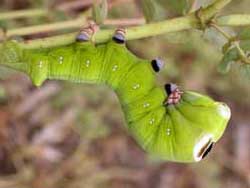 |
Erinnyis ello
WO/KW, Ello Sphinx:
Papaya (Carica papaya), Cnidoscolus
angustidens, poinsettia (Euphorbia pulcherrima),
guava (Psidium species),
saffron plum (Bumelia angustifolia/Bumelia celastrina).
Manilkara bahamensis,
Willow Bustic (Bumelia salicifolia),
Painted Leaf (Poinsettia heterophylla).
Nice socks! Very variable.
|
Erinnyis ello larva, September, 2008, Kelli Whitney
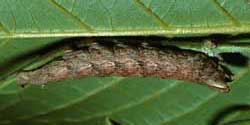 |
Erinnyis obscura, Obscure Sphinx,
WO:
Rauvolfia ligustrina, Rauvolfia tetraphylla,
Stemmadenia obovata, Philibertia, Cynanchum, papaya
(Carica papaya), Asclepiadaceae, Blepharodon mucronatum,
White vine (Sarcostemma clausum), Morrenia odorata.
rare
|
 |
Hemaris thysbe
USGS, Hummingbird Clearwing:
There is also an orangey-pink prepupal form. The lateral line runs
from S1 to the blue horn.
Hemaris thysbe larvae feed on viburnum and related plants.
|
 |
Hemaris diffinis
WO,
Snowberry Clearwing; Bumblebee Moth:
Snowberry (Symphoricarpos),
honeysuckle (Lonicera), Coralberry, viburnums, Blue Dogbane
(Apocynum), dwarf bush honeysuckle (Diervilla lonicera).
Horn black; yellow base.
|
 |
Hemaris gracilis
WO,
Slender Clearwing; Graceful Clearwing:
Larval foods are blueberries including low bush blueberry
(Vaccinium vacillans), and laurel (Kalmia), all in the heath family
(Ericaceae).
|
This species is probably limited to Cuba, being replaced by subspecies floridensis in southern Florida and subspecies
bahamensis in the Bahamas.
In Florida larvae have been found on Black Mangrove (Avicennia germinans), and they are very similar to
the larva of subspecies Madoryx pseudothyreus bahamensis as well as the nominate subspecies.
|
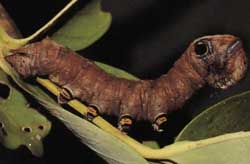 |
Madoryx pseudothyreus floridensis
, the Floridean False-windowed Sphinx.
Females possibly?? lay eggs on evening primrose
(Onagraceae). In southern Florida Madoryx pseudothyreus floridensis larvae have been found on
Black Mangrove (Avicennia germinans). The image to the left is from Florida and represents the subspecies floridensis.
Larvae spin a silken cocoon, affixed to a mangrove branch above ground.
|
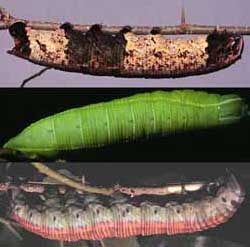
|
Pachylia ficus, Fig Sphinx,
USGS/CM:
Females feed and lay eggs on fig leaves, especially Strangler Fig
(Ficus aurea). Ficus carica, Ficus microcarpa, Ficus
religiosa, Ficus pumila, Ficus gamelleira, Ficus prinoides, Ficus
pumila, Artocarpus integrifolia.
Extremely variable. Green form
has oblique lateral lines.
The few images that have been sent to me for identification help
are usually as per upper image.
|
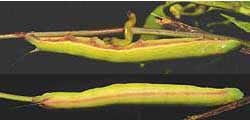 |
Phryxus caicus, the Caicus Sphinx,
USGS:
Mesechites trifida, probably on other
members of Apocynaceae (Dogbane family: Echites). Mangrove rubber vine (Rhabdadenia
biflora).
|
Philampelini tribe:
 |
Eumorpha achemon
WO,
Achemon Sphinx:
Grape (Vitis), Virginia Creeper
(Parthenocissus quinquefolia) and other vines and ivies
(Ampelopsis).
Larvae occur in both a light (green) form and a darker (tan/brown)
form. Note six "segmented" oblique lines.
|
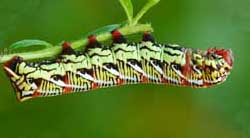 |
Eumorpha fasciatus
USGS, Banded Sphinx:
Primrose-willow, Ludwigia (water primrose),
other plants in evening primrose family.
Highly variable. Large, dark spiracular circles and dark
line in center of back. See image at bottom of this page.
|
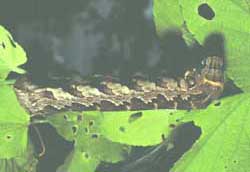 |
Eumorpha labruscae
USGS, Gaudy Sphinx:
Striking resemblance to snake's head and eye, and flattening of
thoracic segments when head is not retracted.
Possum Vine (Cissus sicyoides).
Cissus incisa, Cissus verticillata, Eupatorium odoratum,
Ludwigia,
Magnolia, Parthenocissus and Vitis vinifera are all
reported hosts.
|
 |
Eumorpha pandorus
WO, Pandorus Sphinx:
If you have Grape or Virginia Creeper nearby, then you might encounter
this species. Note five large white ovals. Orangey-brown and green
forms also.
|
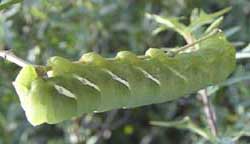 |
Eumorpha vitis
WO,
Vine Sphinx:
Grape (Vitis) and
other vines (Cissus): Cissus pseudosicyoides
and Cissus rhombifolia and Cissus sicycoides.
I suspect there would be a brown form.
Note five, smooth, narrow, oblique white lines.
|
Macroglossini tribe:
 |
Amphion floridensis
USGS,
Nessus Sphinix:
In additon to Virginia creeper larvae accept Grape (Vitis),
ampelopsis (Ampelopsis), and cayenne pepper (Capsicum).
Larvae are green until the final instar.
|
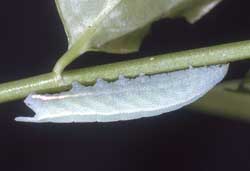 |
Cautethia grotei
WO,
Grote's Sphinx.
Rare in U.S., but there are sightings (mostly of adult moths)
in east from Florida, South Carolina, New Jersey, New York,
Massachusetts,
New Hampshire. David's milkberry/snowberry (Chiococca alba)
in madder family (Rubiaceae); also found on black torch (Erithalis fruiticosa), Common Snowberry (Symphoricarpos albus).
|
 |
Darapsa choerilus
WO, Azalea Sphinx:
Larvae feed on Azalea and Viburnum and progress very rapidly. The
larva to the left on Viburnum cassinoides is getting ready to
pupate. Color change from green to light burgundy-brown indicates
pupation is imminent. |
 |
Darapsa myron
WO, Virginia Creeper Sphinx; Grapevine Sphinx:
If you have the foodplants indicated in the common names, you probably have this
species nearby. Lower wings orange.
Virginia creeper (Parthenocissus quinquefolia),
Grape (Vitis), Ampelopsis, Viburnum. |
 |
Darapsa versicolor
USGS,
Hydrangea Sphinx:
Larvae turn a deep chocolate brown just prior to pupation, and the
"horn" on the tail also turns downward as pupation draws near.
Darapsa versicolor larvae feed on Smooth hydrangea
(Hydrangea arborescens), buttonbush
(Cephalanthus occidentalis), and waterwillow
(Decodon verticillatus).
|
 |
Hyles lineata
USGS, White-lined Sphinx:
Highly varied; willow weed (Epilobium), four o'clock (Mirabilis),
apple (Malus), evening primrose (Oenothera), elm
(Ulmus), grape (Vitis), tomato (Lycopersicon),
purslane (Portulaca), Fuschia.
All larvae seem, however, to have the red/black swellings split by
dorso-lateral lines. |
 |
Sphecodina abbottii
WO,
Abbott's Sphinx:
Feed at night on grape (Vitis), ampelopsis
(Ampelopsis); hide on bark during
the day. Virginia creeper would also be a suitable host. There is also a dark form
without the green patches. Note the "raised eye", replacing the anal horn.
|
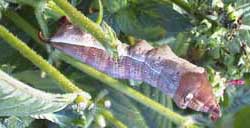 |
Xylophanes pluto
USGS/KW,
Pluto Sphinx:
Milkberry (Chiococca
species), Firebush (Hamelia patens), Indian Mulberry
(Morinda royoc), Erythroxylon.
Three known colour morphs: green, brown, and purple/brown.
|
Xylophanes pluto (green form) on firebush, Kelli Whitney, Park Naturalist II, Long Key Nature Centre, August 30, 2009.
 |
Xylophanes porcus
WO stray,
Porcus Sphinx:
The upperside of the forewing is olive-brown with lighter brown along
the outer margin. The upperside of the hindwing is brown with some
paler spots.
|
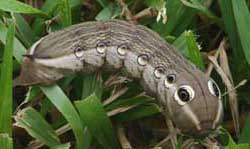 |
Xylophanes tersa
WO,
Tersa Sphinx:
Borreria, Catalpa and Manettia spp. and
Smooth buttonplant (Spermacoce glabra), starclusters
(Pentas species). Joe-pie weed,
Hamelia patens, Hedoydis nigricans. Green form may be more
common.
|
|
|
